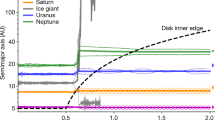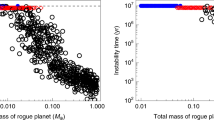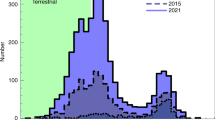Abstract
Atmospheric hydrodynamic escape sculpts the population of low-mass close-in planets. However, distinguishing between the driving mechanisms responsible for the hydrodynamic escape of hydrogen-rich atmospheres is a complex task due to the involvement of many physical factors. Using simulations, I show that hydrodynamic escape can be driven solely by thermal energy deposited in the lower layers of the atmosphere, but only if the planet’s Jeans parameter is below 3. Otherwise, additional exogenous drivers are necessary. To characterize these drivers, an upgraded Jeans parameter that takes into account tidal forces is introduced. When the upgraded Jeans parameter falls below 3 or exceeds 6, atmospheric escape is primarily driven by tidal forces or extreme ultraviolet radiation from the host star, respectively. In the range 3 to 6, both factors can trigger the escape of the atmosphere. The upgraded Jeans parameter, which is closely related to the underlying physics, provides a concise method for categorizing the driving mechanisms of hydrodynamic escape. The results can also be applied to planetary evolution calculations.
This is a preview of subscription content, access via your institution
Access options
Access Nature and 54 other Nature Portfolio journals
Get Nature+, our best-value online-access subscription
$29.99 / 30 days
cancel any time
Subscribe to this journal
Receive 12 digital issues and online access to articles
$119.00 per year
only $9.92 per issue
Buy this article
- Purchase on Springer Link
- Instant access to full article PDF
Prices may be subject to local taxes which are calculated during checkout




Similar content being viewed by others
Data availability
The data that support the results and plots within this paper are available from the corresponding author upon reasonable request.
Code availability
The codes used in this study are based on previously published works, and references are provided in the manuscript. Those references include most details. The results of this paper can be reproduced by incorporating the details supplied within the paper.
References
Vidal-Madjar, A. et al. An extended upper atmosphere around the extrasolar planet HD209458b. Nature 422, 143–146 (2003).
Lammer, H. et al. Atmospheric loss of exoplanets resulting from stellar X-ray and extreme-ultraviolet heating. Astrophys. J. 598, L121–L124 (2003).
Yelle, A. N. Aeronomy of extra-solar giant planets at small orbital distances. Icarus 170, 167–179 (2004).
Koskinen, T. T., Aylward, A. D. & Miller, S. A stability limit for the atmospheres of giant extrasolar planets. Nature 450, 845–848 (2007).
Murray-Clay, R. A., Chiang, E. I. & Murray, N. Atmospheric escape from hot Jupiters. Astrophys. J. 693, 23–42 (2009).
Guo, J. H. Escaping particle fluxes in the atmospheres of close-in exoplanets. I. Model of hydrogen. Astrophys. J. 733, 98 (2011).
Erkaev, N. V. et al. Roche lobe effects on the atmospheric loss from ‘hot Jupiters’. Astron. Astrophys. 472, 329–334 (2007).
Lammer, H. et al. Determining the mass loss limit for close-in exoplanets: what can we learn from transit observations? Astron. Astrophys. 638, A52 (2009).
Petigura, E. A., Marcy, G. W. & Howard, A. W. A plateau in the planet population below twice the size of Earth. Astrophys. J. 770, 69 (2013).
Fulton, B. J. et al. The California-Kepler Survey. III. A gap in the radius distribution of small planets. Astron. J. 154, 109 (2017).
Lopez, E. D. & Fortney, J. J. Understanding the mass–radius relation for sub-Neptunes: radius as a proxy for composition. Astrophys. J. 792, 1 (2014).
Owen, J. E. & Jackson, A. P. Planetary evaporation by UV and X-ray radiation: basic hydrodynamics. Mon. Not. R. Astron. Soc. 425, 2931–2947 (2012).
Jin, S. et al. Planetary population synthesis coupled with atmospheric escape: a statistical view of evaporation. Astrophys. J. 795, 65 (2014).
Howe, A. R. & Burrows, A. Evolutionary models of super-Earths and mini-Neptunes incorporating cooling and mass loss. Astrophys. J. 808, 150 (2015).
Owen, J. E. & Wu, Y. The evaporation valley in the Kepler planets. Astrophys. J. 847, 29 (2017).
Mordasini, C. Planetary evolution with atmospheric photoevaporation. I. Analytical derivation and numerical study of the evaporation valley and transition from super-Earths to sub-Neptunes. Astron. Astrophys. 638, A52 (2020).
Ginzburg, S., Schlichting, S. E. & Sari, R. Super-Earth atmospheres: self-consistent gas accretion and retention. Astrophys. J. 825, 29 (2016).
Ginzburg, S., Schlichting, S. E. & Sari, R. Core-powered mass-loss and the radius distribution of small exoplanets. Mon. Not. R. Astron. Soc. 476, 759–765 (2018).
Lee, E. J., Karalis, A. & Thorngren, D. P. Creating the radius gap without mass loss. Astrophys. J. 941, 186 (2022).
Venturini, J., Guilera, O. M., Haldemann, J., Ronco, M. P. & Mordasini, C. The nature of the radius valley. Hints from formation and evolution models. Astron. Astrophys. 643, L1 (2020).
Izidoro, A. et al. The exoplanet radius valley from gas-driven planet migration and breaking of resonant chains. Astrophys. J. Lett. 939, L19 (2022).
Owen, J. E. & Wu, Y. Q. Atmospheres of low-mass planets: the ‘boil-off’. Astrophys. J. 817, 107 (2016).
Koskinen, T. T. et al. Mass loss by atmospheric escape from extremely close-in planets. Astrophys. J. 929, 52 (2022).
Salz, M., Czesla, M., Schneider, P. C. & Schmitt, J. H. M. M. Simulating the escaping atmospheres of hot gas planets in the solar neighborhood. Astron. Astrophys. 586, 75 (2016).
Jeans, J. H. The Dynamical Theory of Gases (Cambridge Univ. Press, 1925).
Hunten, D. M. Thermal and nonthermal escape mechanisms for terrestrial bodies. Planet. Space Sci. 30, 773–783 (1982).
Johnson, R. E. et al. Exospheres and atmospheric escape. Space Sci. Rev. 139, 355–397 (2008).
Volkov, A. N., Johnson, R. E., Tucker, O. J. & Erwin, J. T. Thermally driven atmospheric escape: transition from hydrodynamic to Jeans escape. Astrophys. J. 729, L24 (2011).
Guo, J. H. Escaping particle fluxes in the atmospheres of close-in exoplanets. II. Reduced mass-loss rates and anisotropic winds. Astrophys. J. 766, 102 (2013).
Kubyshkina, D. et al. Grid of upper atmosphere models for 1–40 M⊕ planets: application to CoRoT-7 b and HD219134 b,c. Astron. Astrophys. 619, A151 (2018).
Yan, D. D. & Guo, J. H. The escape of hydrogen-rich atmosphere of exoplanets: mass-loss rates and the absorption of stellar Lyα. Astrophys. J. 880, 107 (2019).
Allart, R. et al. Spectrally resolved helium absorption from the extended atmosphere of a warm Neptune-mass exoplanet. Science 362, 1384–1387 (2018).
Spake, J. J. et al. Helium in the eroding atmosphere of an exoplanet. Nature 557, 68–70 (2018).
Borsa, F. et al. Atmospheric Rossiter–McLaughlin effect and transmission spectroscopy of WASP-121b with ESPRESSO. Astron. Astrophys. 645, A24 (2021).
Shaikhislamov, I. F. et al. Global 3D hydrodynamic modelling of absorption in Lyα and He 10830 Å lines at transits of GJ3470b. Mon. Not. R. Astron. Soc. 500, 1404–1413 (2021).
Khodachenko, M. L. et al. Simulation of 10830 Å absorption with a 3D hydrodynamic model reveals the solar He abundance in upper atmosphere of WASP-107b. Mon. Not. R. Astron. Soc. Lett. 503, L23–L27 (2021).
Yan, D. D., Guo, J. H., Huang, C. L. & Xing, L. Atmosphere escape inferred from modeling the Hα transmission spectrum of WASP-121b. Astrophys. J. Lett. 907, L47 (2021).
Yan, D. D., Seon, Kwang-il, Guo, J. H., Chen, G. & Li, L. F. Modeling the Hα and He 10830 transmission spectrum of WASP-52b. Astrophys. J. 907, L47 (2022).
Rogers, J. G., Gupta, A., Owen, J. E. & Schlichting, H. E. Photoevaporation versus core-powered mass-loss: model comparison with the 3D radius gap. Mon. Not. R. Astron. Soc. 508, 5886–5902 (2021).
Watson, A. J., Donahue, T. M. & Walker, J. C. The dynamics of a rapidly escaping atmosphere: applications to the evolution of Earth and Venus. Icarus 48, 150 (1981).
Guo, J. H. & Ben-Jaffel, L. The influence of the extreme ultraviolet spectral energy distribution on the structure and composition of the upper atmosphere of exoplanets. Astrophys. J. 818, 90 (2016).
Owen, J. E. & Alvarez, M., A. UV driven evaporation of close-in planets: energy-limited, recombination-limited, and photo-limited flows. Astrophys. J. 816, 34 (2016).
Tian, F., Kasting, J. F., Liu, H. L. & Roble, R. G. Hydrodynamic planetary thermosphere model. 1. Response of the Earth’s thermosphere to extreme solar EUV conditions and the significance of adiabatic cooling. J. Geophys. Res. 113, E05008 (2008).
Krasnopolsky, V. A. Hydrodynamic flow of N2 from Pluto. J. Geophys. Res. 104, 5955 (1999).
Strobel, D. F. N2 escape rates from Pluto’s atmosphere. Icarus 193, 612 (2008).
Johnson, R. E., Volkov, A. N. & Erwin, J. Molecular-kinetic simulations of escape from the ex-planet and exoplanets: criterion for transonic flow. Astrophys. J. Lett. 768, L4 (2013).
Erkaev, N. V. et al. Escape and evolution of Titan’s N2 atmosphere constrained by 14N/15N isotope ratios. Mon. Not. R. Astron. Soc. 500, 2020–2035 (2021).
Erkaev, N. V., Lammer, H., Odert, P., Kulikov, Yu. N. & Kislyakova, K. G. Extreme hydrodynamic atmospheric loss near the critical thermal escape regime. Mon. Not. R. Astron. Soc. 448, 1916–1921 (2015).
Salz, M., Schneider, P. C., Czesla, S. & Schmitt, J. H. M. M. Energy-limited escape revised. Astron. Astrophys. 585, L2 (2016).
Batalha, N. M. et al. Planetary candidates observed by Kepler. III. Analysis of the first 16 months of data. Astrophys. J. Suppl. Ser. 204, 24 (2013).
Masuda, K. Very low-density planets around Kepler-51 revealed with transit timing variations and an anomaly similar to a planet–planet eclipse event. Astrophys. J. 783, 53 (2014).
Jontof-Hutter, D., Dalba, P. A. & Livingston, J. H. TESS observations of Kepler systems with transit timing variations. Astron. J. 164, 42 (2022).
Lammer, H. et al. Identifying the ‘true’ radius of the hot sub-Neptune CoRoT-24b by mass-loss modelling. Mon. Not. R. Astron. Soc. Lett. 461, L62–L66 (2016).
Sanz-Forcada, J. et al. Estimation of the XUV radiation onto close planets and their evaporation. Astron. Astrophys. 532, A6 (2011).
Tu, L., Johnstone, C. P., Güdel, M. & Lammer, H. The extreme ultraviolet and X-ray Sun in time: high-energy evolutionary tracks of a Solar-like star. Astron. Astrophys. 577, L3 (2015).
Huang, C., Arras, P. & Christie, D. A model of the Hα and Na transmission spectrum of HD 189733b. Astrophys. J. 815, 150 (2017).
Fossati, L. et al. Aeronomical constraints to the minimum mass and maximum radius of hot low-mass planets. Astron. Astrophys. 598, A90 (2017).
Gao, P. & Zhang, X. Deflating super-puffs: impact of photochemical hazes on the observed mass–radius relationship of low-mass planets. Astrophys. J. 890, 93 (2020).
Ricotti, M., Gnedin, N. Y. & Shull, J. M. The fate of the first galaxies. I. Self-consistent cosmological simulations with radiative transfer. Astrophys. J. 575, 33–48 (2002).
Dalgarno, A., Yan, Min & Liu, Weihong Electron energy deposition in a gas mixture of atomic and molecular hydrogen and helium. Astrophys. J. Suppl. Ser. 125, 237–256 (1999).
Cecchi-Pestellini, C., Ciaravella, A., Micela, G. & Penz, T. The relative role of EUV radiation and X-rays in the heating of hydrogen-rich exoplanet atmospheres. Astron. Astrophys. 496, 863–868 (2009).
Garcia Munoz, A. Physical and chemical aeronomy of HD 209458b. Planet. Space Sci. 55, 1426 (2007).
Lamers, H. J. G. L. M. & Cassinelli, J. P. Introduction to Stellar Winds (Cambridge Univ. Press, 1999).
Ekenbäck, A. et al. Energetic neutral atoms around HD 209458b: estimations of magnetospheric properties. Astrophys. J. 709, 670–679 (2010).
Lammer, H. et al. Probing the blow-off criteria of hydrogen-rich ‘super-Earths’. Mon. Not. R. Astron. Soc. Lett. 430, 1247–1256 (2013).
Strobel, D. F. Titan’s hydrodynamically escaping atmosphere. Icarus 193, 588 (2008).
Yelle, R. V., Borggren, N. & de la Haye, V. The vertical structure of Titan’s upper atmosphere from Cassini ion neutral mass spectrometer measurements. Icarus 182, 567 (2004).
Gladstone, G. R. & Young, L. A. New Horizons observations of the atmosphere of Pluto. Annu. Rev. Earth Planet. Sci. 47, 119 (2019).
Strobel, D. F., Summers, M. E., Herbert, F. & Sandel, B. R. The photochemistry of methane in the atmosphere of Triton. Geophys. Res. Lett. 17, 1729–1732 (1990).
Krasnopolsky, V. A. & Cruikshank, D. P. Photochemistry of Triton’s atmosphere and ionosphere. J. Geophys. Res. 100, 21271 (1995).
Lammer, H. et al. Loss of hydrogen and oxygen from the upper atmosphere of Venus. Planet. Space Sci. 54, 1445–1456 (2006).
Acknowledgements
This work is supported by the National Natural Science Foundation of China (Grant No. 12288102) and the Strategic Priority Research Program of the Chinese Academy of Sciences (Grant No. XDB 41000000). I also acknowledge support from the National Natural Science Foundation of China (Grant No. 11973082) and the National Key R&D Program of China (Grant No. 2021YFA1600400/2021YFA1600402). I gratefully acknowledge the PHOENIX Supercomputing Platform jointly operated by the Binary Population Synthesis Group and the Stellar Astrophysics Group at Yunnan Observatories, Chinese Academy of Sciences.
Author information
Authors and Affiliations
Contributions
J.G. completed all the contents of this work.
Corresponding author
Ethics declarations
Competing interests
The author declares no competing interests.
Peer review
Peer review information
Nature Astronomy thanks Chenliang Huang, Carolina Villarreal D’Angelo and the other, anonymous, reviewer(s) for their contribution to the peer review of this work.
Additional information
Publisher’s note Springer Nature remains neutral with regard to jurisdictional claims in published maps and institutional affiliations.
Extended data
Extended Data Fig. 1 The distributions of density, separation and Jean parameter λ for planets with different driving mechanisms.
The symbols are the same as those in Fig. 2. (a) the distributions of λ and XUV flux; (b) the distributions of separation and mean density. In generally, the planets have smaller density if their hydrodynamic escapes are TE- and tidally-driven. In contrast, the trend is contrary to the planets with XUV-driven. For TE-driven escape, their λ values are smaller than ∼3. For tidally-driven escape, the values of λ* is smaller than 3. In the regime of tidally-XUV-driven transition regime, the values of λ* are in the range of 3-6. The values of λ* are greater than 6 in XUV-driven regime (see Fig. 1).
Extended Data Fig. 2 The TE-driven escape of the atmosphere.
“Black square”: the atmosphere is composed of hydrogen atoms and Helium; “Red circle”: the atmosphere of Hydrogen molecular; “Green triangle”: the atmosphere is composed of hydrogen molecules and Helium. The two solid lines are λ=2.8 and 3.5, and the region between two solid lines represents the regime of transonic escape for the atmospheres of H2 and H2+He. The dashed line is λ=3.3 that denote the limit of supersonic escape for mon-atomic gases. All filled symbols are supersonic outflow while the triangles and circles denote the case of transonic escape. I also marked the Mach numbers of the lower boundary for the three examples with the lowest mass loss rates. Note that the velocities at the lower boundary are not imposed to equal with the sound speed such that my model predicts very high the mass loss rates. Also note that the tidal forces, XUV irradiation and all chemical reactions are ignored for all planets in the figure.
Extended Data Fig. 3 The atmospheric structures of the TE-driven escape in diatomic atmospheres.
I show two samples with different values of λ. The escapes of both the two planets are driven by their thermal energy, but one is supersonic and the other is transonic.
Extended Data Fig. 4 The distribution of RRoche/Rs-Rxuv/Rs and the relationship between the location of sonic point and optical depths of XUV spectrum.
The dependence of the altitude distribution of the Roche radius, average absorption radius of XUV radiation and position of the sound point on the upgraded Jeans parameter. All planets orbiting G- and M-type are included. “red circle”: λ* < 3; “green triangle”: 3 < λ* < 6; “blue star”: λ* > 6.
Extended Data Fig. 5 The structure of the atmosphere for two planets around the turning point of neutral and ionized wind.
The XUV flux received by them is 5.4 × 104erg/s/cm2. The black lines denote the case of neutral atmosphere (Mp = 12M⊕, Rp = 1R⊕, and gravitational potential ϕ = 7.50 × 1012 erg/g) while the red lines are the ionized atmosphere (Mp = 20M⊕, Rp = 1R⊕, gravitational potential ϕ = 1.25 × 1013 erg/g). ‘Solid line”: the number density of hydrogen atoms; ‘Dashed line”: the number density of hydrogen ions; ‘Dotted line”: the temperature profiles.
Supplementary information
Supplementary Information
Supplementary Discussion and Figs. 1–3.
Rights and permissions
Springer Nature or its licensor (e.g. a society or other partner) holds exclusive rights to this article under a publishing agreement with the author(s) or other rightsholder(s); author self-archiving of the accepted manuscript version of this article is solely governed by the terms of such publishing agreement and applicable law.
About this article
Cite this article
Guo, J.H. Characterization of the regimes of hydrodynamic escape from low-mass exoplanets. Nat Astron (2024). https://doi.org/10.1038/s41550-024-02269-w
Received:
Accepted:
Published:
DOI: https://doi.org/10.1038/s41550-024-02269-w



